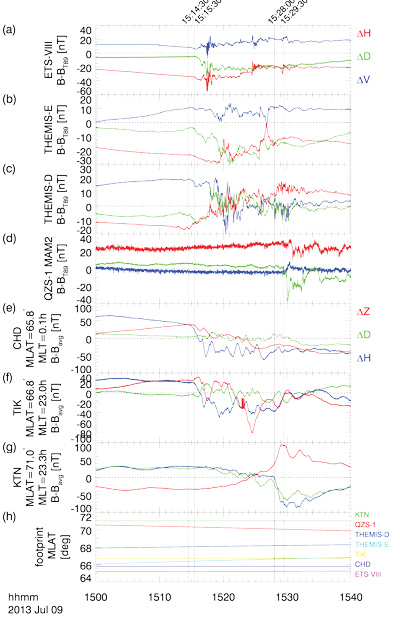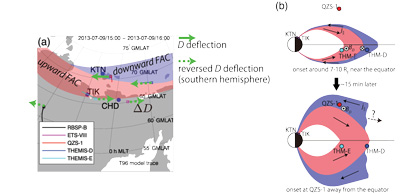
2020 THEMIS SCIENCE NUGGETS
Evolution of field-aligned current in the meridional plane during substorm: multipoint observations from satellites and ground stations
by Shun Imajo
Institute for Space-Earth Environmental Research (ISEE)
Nagoya University
Introduction
A substorm is a manifestation of energy release in the nightside magnetosphere accompanied by bright and dynamic auroras. Magnetic fluctuations associated with the substorm reflects the structure and development of electric currents, which carry electromagnetic energy. A typical magnetic signature in the geosynchronous orbit (6.6 RE: Earth’s radii) is a sudden increase in the magnetic field being aligned with the magnetic dipole axis, the so-called magnetic depolarization. The deflection of the east-west magnetic field is also observed with the dipolarization, which is consistent with the development of field-aligned currents (FACs), which are connected into the ionosphere. Dipolarizations propagate both earthward and tailward in the radial distance range of 4–30 RE. Because the observations around the geosynchronous altitude have been limited in the near equator below 20˚ magnetic latitude, the latitudinal distribution of magnetic fluctuations in the magnetosphere, i.e., configuration and development of the substorm current system, has not been well understood.
| Figure 1. Positions of satellites in GSM coordinates in (a) X-Y plane and (b) meridional plane during 15:00–16:00 UT on July 9, 2013. The magnetic field line is estimated by the Tsyganenko 96 model at 15:15 UT, and the green dot is the magnetic equator on the field line. (c) Positions of ionospheric footprints of satellites and ground magnetic observatories during 15:00–16:00 UT on July 9, 2013. The ionospheric footprints are estimated by the Tsyganenko 96 model with fixed parameter obtained from solar wind data and SYM-H index at 15:15 UT. The grids show AACGM geomagnetic latitude and magnetic local time. The local time grids are calculated at 15:15 UT and spaced by an hour. |
In this study, we examine magnetic fluctuations in the near-earth magnetotail in the same meridional plane and its relation to ground magnetic phenomena. The main advantage of this study is simultaneous observations by near-equatorial satellites and the first Quasi-Zenith Satellite (QZS-1) away from the magnetic equator. Since QZS-1 stays in the specific longitude around Japan, the geosynchronous satellite ETS-VIII and the ground magnetometer in Kotelny Island near the ionospheric footprint of QZS-1 are always located in the close magnetic local time. We analyze a substorm event on July 9, 2013 during 15:00–16:00 Universal time (UT) when QZS-1 was located at 31˚ dipole magnetic latitude (MLAT) and 23.5 h dipole magnetic local time (MLT), the Radiation Belt Storm Probe B (RBSP-B) satellite was located inside the geosynchronous altitude, and Time History of Events and Macroscale Interactions during Substorms D (THEMIS-D) and THEMIS-E were located outside the geosynchronous altitude in the similar MLT of QZS-1 (Figure 1).
| Figure 2. Magnetic field data from (a) ETS-VIII, (b) THEMIS-E, (c) THEMIS-D, (d) QZS-1, (e) CHD, (f) TIK, and (g) KTN. The satellite magnetic field data are subtracted by the Tsyganenko 89 model field at Kp=0. The ground magnetic field data are subtracted by values averaged by their values in the plotted interval. The MLTs are AACGM MLTs at 15:15 UT. (h) AACGM magnetic latitude at 100 km in altitude of ionospheric footprints of satellites and ground observatories. |
Results
Figure 2 shows magnetic field data from the satellites equal to or farther than the geosynchronous altitude and the high-latitude ground observatories. Typical magnetic depolarization signatures were first observed at THEMIS-D at ~15:14:30 UT (Figure 2c). About 1 min later, ETS-VIII and THEMIS-E observed a strong westward deflection (Figures 2a and 2b). This indicates the magnetic fluctuation propagated earthward in the region in 6.6–10 RE near the magnetic equator. The QZS-1 satellite away from the magnetic equator observed a strong westward deflection at 15:29:30 UT (Figure 2d) with a long delay of 15 min from the first variation at THEMIS-D. This time delay, which is much longer than radial propagation time reported by previous studies, indicates that the magnetic fluctuation propagated tailward (or poleward) between THEMIS-D and QZS-1.
A decrease in the horizontal magnetic field on the ground, the so-called negative bay, shows a similar delay between the stations near the footprint of the satellites. The negative bay observed at CHD and TIK started at ~15:15:00 UT, almost the same timing at satellites near the magnetic equator (Figures 2e and 2f). On the other hand, KTN near the footprint of QZS-1 observed a negative bay at 15:28:00 UT, which is close to but slightly earlier than the onset at QZS-1 (Figure 2g). The ground observation near the footprint indicates that the poleward expansion of the westward electrojet is consistent with the tailward propagation of magnetic fluctuations in the magnetosphere.
| Figure 3. Schematic illustrations of possible FAC distributions (a) on the ionosphere at the time when magnetic fluctuations reached QZS-1 and KTN and (b) in the magnetosphere near the midnight meridional plane at the first onset and QZS-1 onset. The blue area shows the earthward (downward) FAC, and the red area shows the tailward (upward) FAC. The solid green arrow shows the direction of azimuthal magnetic field variation. The dotted green arrow shows the opposite direction of the azimuthal magnetic field variation observed in the Southern Hemisphere with respect to the magnetic equator. |
Conclusion
Figure 3a shows a possible distribution of FACs on the ionosphere deduced from the satellite observations. The east-west component of magnetic field variations observed in the Southern Hemisphere is reversely translated to the Northern Hemisphere and is shown as dotted green arrows. Based on ground magnetic data at low latitudes, QZS-1 was on the western side of the substorm current system where magnetic effects of the upward FAC are dominant. The westward magnetic field deflection at QZS-1 can be explained if the downward current in the higher-latitude region extends westward. In this case, there are two-layer current sheets at the meridian of QZS-1; the upward current on the equatorward side and the downward current on the poleward side. The magnetic perturbation outside the current sheets is weak, and a strong westward magnetic perturbation is created near the boundary between upward and downward currents. THEMIS-D in the Southern Hemisphere, which observed the eastward deflection (corresponding to the westward deflection in the Northern Hemisphere), is also considered to be located near the boundary of the FACs. The east-west magnetic field variations at the satellites in the equatorward side of the FACs (ETS-VIII and THEMIS-E) are considered to be a temporal development of the magnitude of the upward current.
Our results indicate that the propagation of the magnetic fluctuation does not only depend on the radial distance but also strongly depends on the magnetic latitude. Figure 3b shows a possible evolution of FACs in the meridional plane near midnight. Based on the timing consistency between ground magnetometers and satellites, the FACs were connected from the ionosphere to at least the position of QZS-1 in the magnetosphere. The poleward moving speed of the FAC in the magnetosphere and the westward electrojet is consistent with a typical speed of the auroral poleward expansion.
Reference
Imajo, S., Nosé, M., Aida, M., Higashio, N., Matsumoto, H., Kiyokazu, K., Smith, C., MacDowall, R.J., Yoshikawa, A. (2020) Evolution of field-aligned current in the meridional plane during substorm: multipoint observations from satellites and ground stations. Earth Planets Space 72, 58. https://doi.org/10.1186/s40623-020-01182-6Biographical Note
Shun Imajo is a researcher at Institute for Space-Earth Environmental Research (ISEE), Nagoya University in Japan. His main research interests are magnetospheric-ionospheric current systems, geomagnetic pulsations, auroral particle acceleration, and magnetic field measurements.
 Please send comments/suggestions to
Emmanuel Masongsong / emasongsong @ igpp.ucla.edu
Please send comments/suggestions to
Emmanuel Masongsong / emasongsong @ igpp.ucla.edu



